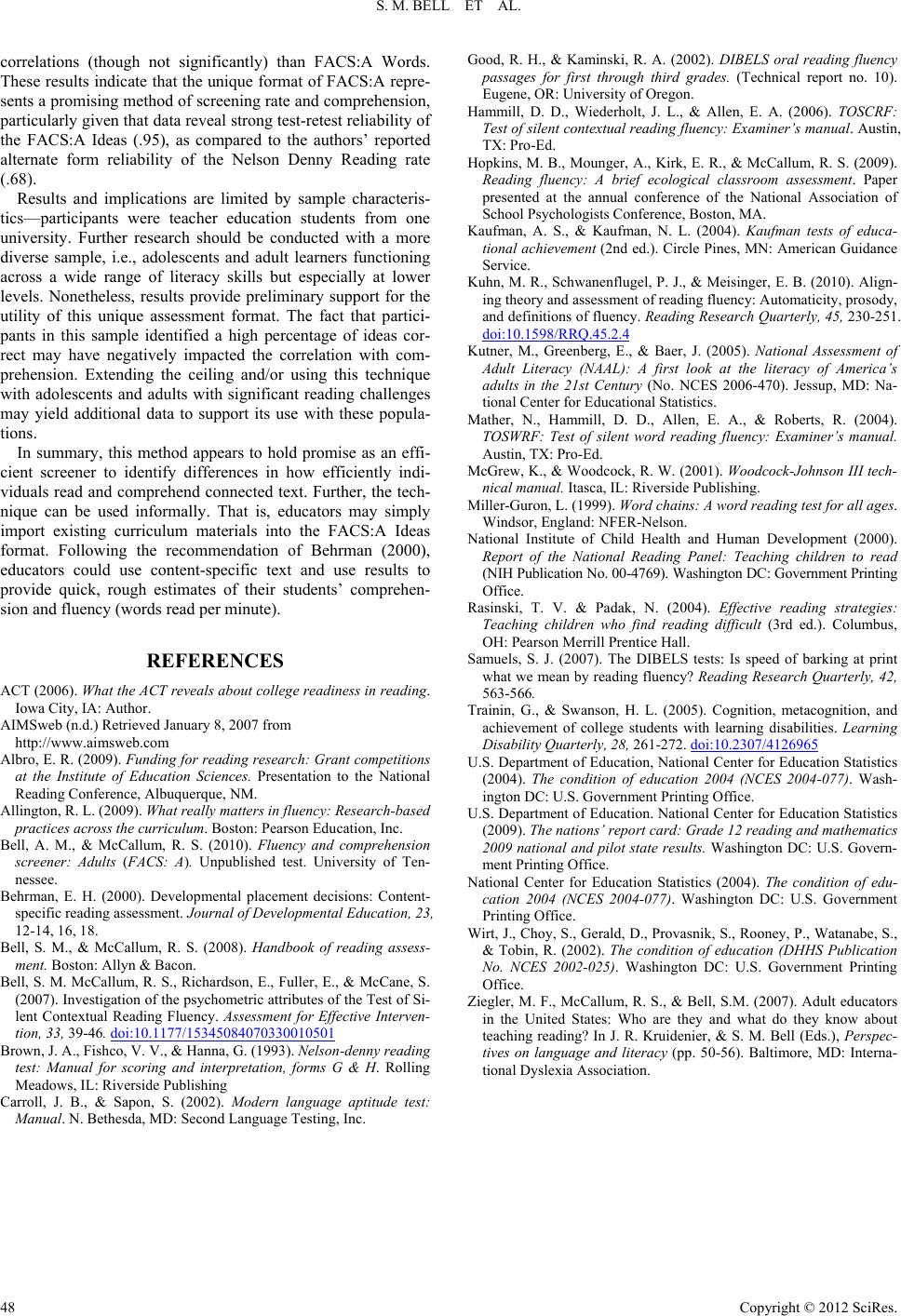
S. M. BELL ET AL.
correlations (though not significantly) than FACS:A Words.
These results indicate that the unique format of FACS:A repre-
sents a promising method of screening rate and comprehension,
particularly given that data reveal strong test-retest reliability of
the FACS:A Ideas (.95), as compared to the authors’ reported
alternate form reliability of the Nelson Denny Reading rate
(.68).
Results and implications are limited by sample characteris-
tics—participants were teacher education students from one
university. Further research should be conducted with a more
diverse sample, i.e., adolescents and adult learners functioning
across a wide range of literacy skills but especially at lower
levels. Nonetheless, results provide preliminary support for the
utility of this unique assessment format. The fact that partici-
pants in this sample identified a high percentage of ideas cor-
rect may have negatively impacted the correlation with com-
prehension. Extending the ceiling and/or using this technique
with adolescents and adults with significant reading challenges
may yield additional data to support its use with these popula-
tions.
In summary, this method appears to hold promise as an effi-
cient screener to identify differences in how efficiently indi-
viduals read and comprehend connected text. Further, the tech-
nique can be used informally. That is, educators may simply
import existing curriculum materials into the FACS:A Ideas
format. Following the recommendation of Behrman (2000),
educators could use content-specific text and use results to
provide quick, rough estimates of their students’ comprehen-
sion and fluency (words read per minute).
REFERENCES
ACT (2006). What the ACT reveals about college readiness in reading.
Iowa City, IA: Author.
AIMSweb (n.d.) Retrieved January 8, 2007 from
http://www.aimsweb.com
Albro, E. R. (2009). Funding for reading research: Grant competitions
at the Institute of Education Sciences. Presentation to the National
Reading Conference, Albuquerque, NM.
Allington, R. L. (2009). What really matters in fluency: Research-based
practices across the curriculum. Boston: Pearson Education, Inc.
Bell, A. M., & McCallum, R. S. (2010). Fluency and comprehension
screener: Adults (FACS: A). Unpublished test. University of Ten-
nessee.
Behrman, E. H. (2000). Developmental placement decisions: Content-
specific reading assessment. Journal of Developmental Education, 23,
12-14, 16, 18.
Bell, S. M., & McCallum, R. S. (2008). Handbook of reading assess-
ment. Boston: Allyn & Bacon.
Bell, S. M. McCallum, R. S., Richardson, E., Fuller, E., & McCane, S.
(2007). Investigation of the psychometric attributes of the Test of Si-
lent Contextual Reading Fluency. Assessment for Effective Interven-
tion, 33, 39-46. doi:10.1177/15345084070330010501
Brown, J. A., Fishco, V. V., & Hanna, G. (1993). Nels on-denny read i ng
test: Manual for scoring and interpretation, forms G & H. Rolling
Meadows, IL: Riverside Publishing
Carroll, J. B., & Sapon, S. (2002). Modern language aptitude test:
Manual. N. Bethesda, MD: Second Language Testing, Inc.
Good, R. H., & Kaminski, R. A. (2002). DIBELS oral reading fluency
passages for first through third grades. (Technical report no. 10).
Eugene, OR: University of Oregon.
Hammill, D. D., Wiederholt, J. L., & Allen, E. A. (2006). TOSCRF:
Test of silent contextual reading fluency: Examiner’s manual. Austin,
TX: Pro-Ed.
Hopkins, M. B., Mounger, A., Kirk, E. R., & McCallum, R. S. (2009).
Reading fluency: A brief ecological classroom assessment. Paper
presented at the annual conference of the National Association of
School Psychologists Conference, Boston, MA.
Kaufman, A. S., & Kaufman, N. L. (2004). Kaufman tests of educa-
tional achievement (2nd ed.). Circle Pines, MN: American Guidance
Service.
Kuhn, M. R., Schwanenflugel, P. J., & Meisinger, E. B. (2010). Align-
ing theory and assessment of reading fluency: Automaticity, prosody,
and definitions of fluency. Reading Research Quarterly, 45, 230-251.
doi:10.1598/RRQ.45.2.4
Kutner, M., Greenberg, E., & Baer, J. (2005). National Assessment of
Adult Literacy (NAAL): A first look at the literacy of America’s
adults in the 21st Century (No. NCES 2006-470). Jessup, MD: Na-
tional Center for Educational Statistics.
Mather, N., Hammill, D. D., Allen, E. A., & Roberts, R. (2004).
TOSWRF: Test of silent word reading fluency: Examiner’s manual.
Austin, TX: Pro-Ed.
McGrew, K., & Woodcock, R. W. (2001). Woodcock-Johnson III tech-
nical manual. Itasca, IL: Riverside Publishing.
Miller-Guron, L. (1999). Word chains: A word reading test for all ages.
Windsor, England: NFER-Nelson.
National Institute of Child Health and Human Development (2000).
Report of the National Reading Panel: Teaching children to read
(NIH Publication No. 00-4769). Washington DC: Government Printing
Office.
Rasinski, T. V. & Padak, N. (2004). Effective reading strategies:
Teaching children who find reading difficult (3rd ed.). Columbus,
OH: Pearson Merrill Prentice Hall.
Samuels, S. J. (2007). The DIBELS tests: Is speed of barking at print
what we mean by reading fluency? Reading Research Quarterly, 42,
563-566.
Trainin, G., & Swanson, H. L. (2005). Cognition, metacognition, and
achievement of college students with learning disabilities. Learning
Disability Quarterly, 28, 261-272. doi:10.2307/4126965
U.S. Department of Education, National Center for Education Statistics
(2004). The condition of education 2004 (NCES 2004-077). Wash-
ington DC: U.S. Government Printing Office.
U.S. Department of Education. National Center for Education Statistics
(2009). The nations’ report card: Grade 12 reading and mathematics
2009 national and pilot state results. Washington DC: U.S. Govern-
ment Printing Office.
National Center for Education Statistics (2004). The condition of edu-
cation 2004 (NCES 2004-077). Washington DC: U.S. Government
Printing Office.
Wirt, J., Choy, S., Gerald, D., Provasnik, S., Rooney, P., Watanabe, S.,
& Tobin, R. (2002). The condition of education (DHHS Publication
No. NCES 2002-025). Washington DC: U.S. Government Printing
Office.
Ziegler, M. F., McCallum, R. S., & Bell, S.M. (2007). Adult educators
in the United States: Who are they and what do they know about
teaching reading? In J. R. Kruidenier, & S. M. Bell (Eds.), Perspec-
tives on language and literacy (pp. 50-56). Baltimore, MD: Interna-
tional Dyslexia Association.
Copyright © 2012 SciRes.
48